
Orchids are plants that belong to the family Orchidaceae, a diverse and widespread group of flowering plants with blooms that are often colourful and fragrant. Orchids are cosmopolitan plants that are found in almost every habitat on Earth except glaciers. The world's richest diversity of orchid genera and species is found in the tropics.

The Pleurothallidinae are a neotropical subtribe of plants of the orchid family (Orchidaceae) including 29 genera in more than 4000 species.

Cypripedioideae is a subfamily of orchids commonly known as lady's slipper orchids, lady slipper orchids or slipper orchids. Cypripedioideae includes the genera Cypripedium, Mexipedium, Paphiopedilum, Phragmipedium and Selenipedium. They are characterised by the slipper-shaped pouches of the flowers – the pouch traps insects so they are forced to climb up past the staminode, behind which they collect or deposit pollinia, thus fertilizing the flower. There are approximately 165 species in the subfamily.
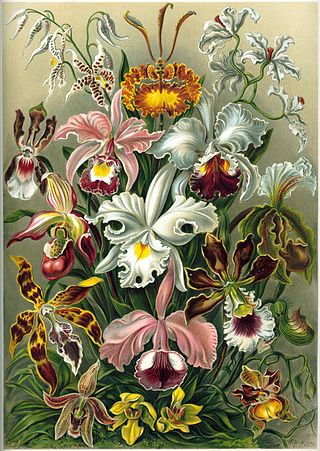
The taxonomy of the Orchidaceae (orchid family) has evolved slowly during the last 250 years, starting with Carl Linnaeus who in 1753 recognized eight genera. De Jussieu recognized the Orchidaceae as a separate family in his Genera Plantarum in 1789. Olof Swartz recognized 25 genera in 1800. Louis Claude Richard provided us in 1817 with the descriptive terminology of the orchids. (See External links below). The next step was taken in 1830-1840 by John Lindley, who recognized four subfamilies. He is generally recognized as the father of orchid taxonomy. The next important step was taken by George Bentham with a new classification, recognizing subtribes for the first time. This classification was first presented in a paper that Bentham read to the Royal Society in 1881. Then it was published in 1883 in the final volume of Genera Plantarum. The next great contributors were Pfitzer (1887), Schlechter (1926), Mansfeld (1937), Dressler and Dodson (1960), Garay (1960, 1972), Vermeulen (1966), again Dressler (1981). and Burns-Balogh and Funk (1986). Dressler's 1993 book had considerable influence on later work.

The Orchidoideae, or the orchidoid orchids, are a subfamily of the orchid family (Orchidaceae) that contains around 3630 species. Species typically have a single (monandrous), fertile anther which is erect and basitonic.
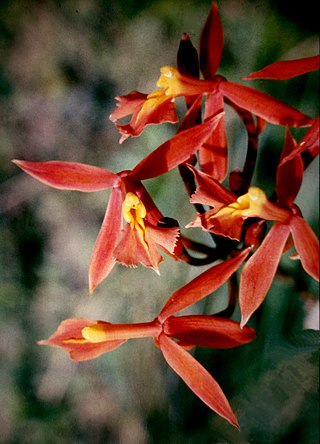
Epidendroideae is a subfamily of plants in the orchid family, Orchidaceae. Epidendroideae is larger than all the other orchid subfamilies together, comprising more than 15,000 species in 576 genera. Most epidendroid orchids are tropical epiphytes, typically with pseudobulbs. There are, however, some terrestrials such as Epipactis and even a few myco-heterotrophs, which are parasitic upon mycorrhizal fungi.

Odontorrhynchus is a genus of orchids belonging to the subfamily Orchidoideae. It constrains 6 known species, all native to the southern half of South America.
- Odontorrhynchus alticolaGaray - Peru, Argentina
- Odontorrhynchus castillonii(Hauman) M.N.Correa - Bolivia, Argentina
- Odontorrhynchus domeykoanusSzlach. - Chile
- Odontorrhynchus erosusSzlach. - Chile
- Odontorrhynchus monstrosusSzlach. - Bolivia
- Odontorrhynchus variabilisGaray - Chile
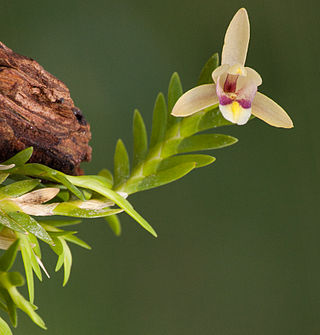
The Vandeae is a large monophyletic tribe within the family of orchids.
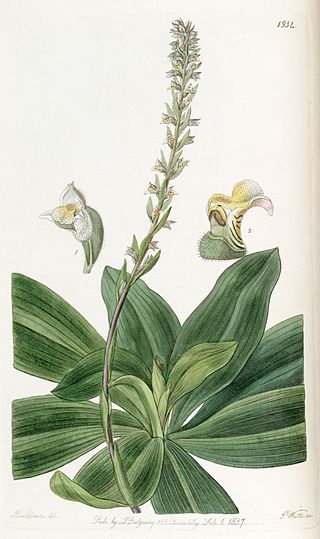
Brachystele is a genus of flowering plants from the orchid family, Orchidaceae. It consists of 20 species native primarily to South America but with a few species in Mexico, Central America, and Trinidad & Tobago.
- Brachystele arechavaletae(Kraenzl.) Schltr.
- Brachystele bicrinitaSzlach.
- Brachystele bracteosa(Lindl.) Schltr.
- Brachystele burkartiiM.N.Correa
- Brachystele camporum(Lindl.) Schltr.
- Brachystele chlorops(Rchb.f.) Schltr.
- Brachystele cyclochila(Kraenzl.) Schltr.
- Brachystele delicatula(Kraenzl.) Schltr.
- Brachystele dilatata(Lindl.) Schltr.
- Brachystele guayanensis(Lindl.) Schltr.
- Brachystele luzmarianaSzlach. & R.González
- Brachystele maasiiSzlach.
- Brachystele oxyanthosSzlach
- Brachystele pappulosaSzlach
- Brachystele scabrilinguaSzlach
- Brachystele subfiliformis(Cogn.) Schltr
- Brachystele tamayoanaSzlach.
- Brachystele unilateralis(Poir.) Schltr
- Brachystele waldemariiSzlach.
- Brachystele widgrenii(Rchb.f.) Schltr.
Clematepistephium is a genus of flowering plants from the orchid family, Orchidaceae. It contains only one known species, Clematepistephium smilacifolium, endemic to the island of New Caledonia. Its closest relative is Eriaxis, also endemic to New Caledonia.

Dossinia is a genus of flowering plants from the orchid family, Orchidaceae. At the present time, only one species is accepted, Dossinia marmorata, endemic to Borneo.

Gavilea is a genus of flowering plants from the orchid family, Orchidaceae. It is native to Chile, Argentina and the Falkland Islands.
Phragmorchis is a monotypic genus of flowering plants from the orchid family, Orchidaceae. The sole species is Phragmorchis teretifolia, endemic to the Island of Luzon in the Philippines.
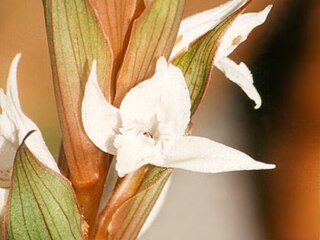
Pteroglossa is a genus of flowering plants from the orchid family, Orchidaceae. It is native to South America, Central America, and Mexico.
- Pteroglossa euphlebia(Rchb.f.) Garay - Rio de Janeiro
- Pteroglossa glazioviana(Cogn.) Garay - Brazil, Paraguay
- Pteroglossa hilariana(Cogn.) Garay - Brazil
- Pteroglossa lurida(M.N.Correa) Garay - Brazil, Paraguay, Argentina
- Pteroglossa luteolaGaray - Argentina
- Pteroglossa macrantha(Rchb.f.) Schltr. - Brazil, Paraguay, Venezuela
- Pteroglossa magnificaSzlach. - Paraguay
- Pteroglossa regia(Kraenzl.) Schltr. - Argentina
- Pteroglossa rhombipetalaGaray - Paraguay, Argentina
- Pteroglossa roseoalba(Rchb.f.) Salazar & M.W.Chase - widespread from Oaxaca to Argentina
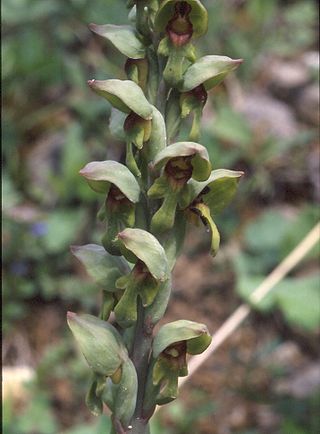
Steveniella is a genus of flowering plants from the orchid family, Orchidaceae. Only one species is known, Steveniella satyrioides, native to Iran, Turkey, Crimea and the Caucasus.
Systeloglossum is a genus of flowering plants from the orchid family, Orchidaceae. It contains 5 known species, all native to southeastern Central America and northwestern South America.
- Systeloglossum acuminatumAmes & C.Schweinf. - Costa Rica, Panama
- Systeloglossum bennettii(Garay) Dressler & N.H.Williams - Peru
- Systeloglossum costaricenseSchltr. - Peru
- Systeloglossum ecuadorense(Garay) Dressler & N.H.Williams - Ecuador
- Systeloglossum panamenseDressler & N.H.Williams - Panama

Dendrobieae is a tribe in the subfamily Epidendroideae, in the family Orchidaceae. The Dendrobieae are mostly tropical, epiphytic orchids which contain pseudobulbs.
Chloraea elegans is an orchid species endemic to the Salta region of Argentina.

Zygopetalinae is an orchid subtribe in the tribe Cymbidieae with 418 species.
Maevia Noemí Correa (1914–2005) was an Argentine botanist, researcher, botanical curator, and professor. She studied at the Faculty of Natural Sciences and Museum Studies at the National University of La Plata, and in 1953 completed a doctorate in natural sciences at the same university, with a dissertation titled, "Las Orquídeas Argentinas de la Tribu Polychondreae Schltr., subtribu Spiranthinae Pfitzer", under the direction of Dr. Ángel Lulio Cabrera. Between 1956 and 1957, the American Association of University Women sponsored her study at the University of California, Berkeley. From 1956 to 1958, she served as technical researcher at the Ministerio de Agricultura y Ganadería, and the Botany Institute in Argentina. She is associated with the National Agricultural Technology Institute (NITA) and served there between 1958 and 1983 as a technical researcher. She worked on several projects during her career including "Estudio y relevamiento de la Flora Patagónica", and "Estudio taxonómico de la Flora Patagónica". She served as herbarium curator, and as the Argentine National Coordinator of the Regional Flora Plan (1981–1990).















